Appears In
The Department of Veterans Affairs (VA’s) Digital Transformation has helped VA modernize its systems and infrastructure with new capabilities that are reaping real VA and Veterans benefits — benefits like faster claims reviews through more consistent IT systems uptime, and higher quality telehealth video calls through continuous optimization of telehealth services bandwidth. These benefits are a part of a comprehensive solution the Office of Information and Technology (OIT) has deployed to help identify and mitigate IT trends before they impact care and services — app monitoring. With the novel coronavirus (COVID-19) pandemic shifting much of traditional VA care and services to online options, advanced app monitoring is more important than ever to ensure Veterans and staff can confidently access VA information and technology. App monitoring works by diagnosing problems before they impact mission-critical systems, preventing service interruptions while also giving VA insights on how to enhance existing technology.
To build out this capability, OIT leveraged strong relationships with industry partners who specialize in aggregating and integrating data. OIT created summation dashboards for critical VA initiatives such as MISSION Act, Colmery, Blue Water Navy. In Spring 2020, VA started building dashboards that integrate multiple data sources to support Electronic Health Record Modernization (EHRM) and other major transformation efforts. When the COVID-19 pandemic began, IT teams pivoted to assemble a telehealth monitoring dashboard. By consolidating data and standardizing data tools, IT teams could effectively monitor dashboards, reduce data complexities, and quickly respond to emerging needs.
Application Monitoring Minimizes End User Disruptions
To stay ahead of a surge in demand, OIT quintupled the capacity of VA’s primary telehealth system, VA Video Connect, to allow more clinicians and patients to conduct remote appointments simultaneously. Veterans Health Administration clinicians now frequently conduct more than 36,000 telehealth to-home VA Video Connect appointments daily, compared to fewer than 2,500 video appointments each day in January and February. To ensure that VA Video Connect would continue to operate smoothly, Site Reliability Engineers from OIT’s Operations Triage Group created a robust set of new monitoring dashboards that aggregate data from multiple sources to shed light on telehealth system behavior. These new dashboards allow the IT monitoring team to easily gather disparate data and work with Site Reliability Engineers and other IT engineers to investigate and resolve issues within just hours, rather than days. Alongside a real-time view of call and video quality, the dashboards let the monitoring team see call and conference counts, errors and warnings, and calls by caller location. As of early June, OIT’s monitoring experts have been using this new tool to examine data from 10 different sources and analyze over 72 million events every day. These monitoring efforts enabled the quick identification and subsequent resolution of connection errors impacting Veterans on VA Video Connect, reducing errors from as many as 1,000 users per day to fewer than 10.
The Bed Management System (BMS) is a critical enterprise-level application that manages beds for all VA facilities. Whenever Veterans are admitted to medical centers, BMS helps identify bed availability. The system assesses ward location, connection to certain resources, and whether a given bed is clean or not. During the COVID-19 pandemic, BMS has proven key to making sure beds went to patients who demonstrated the most need. Accordingly, BMS is central to VA’s ability to efficiently support Fourth Mission requests from cities, states, and non-VA facilities who needed overflow to VA facilities.
During normal monitoring, OIT’s Enterprise Command Center (ECC) noticed an elevated number of authentication errors in BMS after a software update. Understanding that prior BMS incidents in had commonly been tagged as critical priority incidents, ECC immediately reached out to BMS sustainment team to investigate and engage in analysis. Supported by the Austin Information Technology, the issue was resolved in a week. Most importantly, the quick response enabled by app monitoring allowed OIT to resolve the problem before there was any impact to business partners.
Another case of averted impact occurred when OIT identified a low disk space issue at the Miami VA Medical Center (VAMC). If unresolved, low disk space on the VAMC’s systems could have led to frozen screens when medical records were accessed. ECC received an automated alert noting that the disk space had become scarce. Informed by OIT’s monitoring software, ECC immediately contacted the on-call VA technicians to look into the issue. The technicians enlarged the disk size and resolved the issue before it caused any impact to VAMC staff and service continued uninterrupted.
OIT’s advanced app monitoring empowers VA to be proactive in detecting potential issues and resolving them before customers experience disruptions or delays. Rather than relying on business partners or Veterans to contact IT support, OIT’s app monitoring keeps VA ahead of the curve across the enterprise and seamlessly continues serving Veterans with the highest standards of care.






